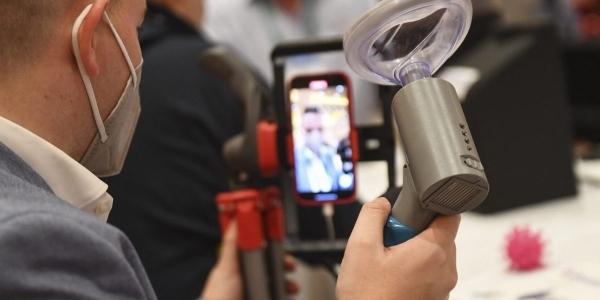
Amid the horror of a global pandemic, it happened: Digital health exploded. The urgency of the COVID crisis provided a once-in-a-century opportunity to jump-start innovation in preventive care. However, if we are not careful, this opportunity will slip through our hands.
Policymakers enabled access to telehealth and advanced the incorporation of artificial intelligence (A.I.) in medical devices. Governments spent billions to make home COVID testing accessible. The U.S. alone dedicated $47.8 billion to implement a national at-home COVID testing strategy, including improvements in data sharing and diagnostics—roughly $143 per person. Health administrators rose to the occasion and introduced cost-saving digital improvements that accelerated home care and improved the detection of chronic diseases, the leading drivers of death and costs in the U.S.
It was a rare “Marshall Plan moment” to rebuild health care in a more affordable, efficient, and humane way. Yet our industry risks squandering this opportunity if we don’t change our discourse and stop overselling what our technology can do. Tech entrepreneurs, who claim that the post-COVID era is the time to be “disrupters” by blowing up the system as we know it and replacing it with something entirely different, are doing a great disservice to health care.
Adopting the Silicon Valley culture of “move fast and break things” in health care will have a cost we cannot bear. It will impact patients’ health and safety, risk hospitals’ resilience, and compromise the regulators’ trust.
The sentencing of Elizabeth Holmes to 11 years in prison is a grim reminder of the devastating consequences the “disruption” hype can have for health care.
We can’t afford to go back. Nearly one in four Americans skip medical care because of the cost. Health expenditure accounts for 20% of the U.S. GDP and is expected to keep growing. Persistent inflation will only aggravate the problem. The current situation is unsustainable.
Paradoxically, the very promises of the digital health boom are now undermining its future. Many publicly traded companies, which were recently valued in the billions, are now trading for cents on the dollar. They overpromised and underdelivered, wasted billions that were earmarked to improve patient care, and jeopardized the already fragile trust of regulators and investors.
Media hype compounded the problem as journalists trumpeted the fairy tale of health-tech unicorns and private companies with “game-changing” products to transform the health care system as we know it.
We have been here before. Some might remember the early predictions that A.I. would replace doctors. In 2014, IBM announced that its Watson system would revolutionize cancer care. Under the hood, its A.I. had trouble even distinguishing between different forms of cancer. In 2016, A.I. pioneer Geoffrey Hinton proclaimed that radiologists would be obsolete in a few years. In both cases, the work is still preliminary, and experts say it will be years before such solutions come to pass.
If exaggeration is bad for trust, outright deception is fatal. At the height of the Theranos hype in 2014, Elizabeth Holmes falsely claimed that her company, valued at $10 billion, could run hundreds of tests on a single drop of blood. At the time, investors urged me to make my own startup “more like Theranos.” Just two years later, they asked me to prove we were nothing like Theranos!
The damage caused to the industry was immeasurable. Shocked and disappointed, venture capital firms opted for “safer” sectors. Regulators halted approvals. Years of investment were lost over one Stanford graduate’s crimes.
In the wake of COVID, massive government investments and new regulation initiatives made 2021 a record-breaking year for digital health, with private financial rounds reaching nearly $30 billion in the U.S. alone. However, 2022 saw a precipitous drop in funding and valuations. Blaming the economic downturn is not a sufficient explanation when, in fact, digital health suffered more than other tech sectors.
When done right and built around clinical-grade innovation and alongside medical protocols of verification, digital health is deflationary and can be more resilient to market trends. The next crop of companies must be built to last. To do that, we must cultivate an honest conversation about what innovation can and cannot achieve. Otherwise, we’ll wake up five years from now to hundreds of billions spent with no real value or clinical impact to show for it.
Instead of talking about disruption, we need to talk about collaboration. Instead of promising a panacea, we need to produce innovation that supports sustainable, systemic progress, especially on mass-population health problems. Above all, we must listen: Let the expertise of physicians and health administrators and the needs of patients drive our decision-making instead of getting ahead of ourselves.
Yonatan Adiri is the founder and CEO of Healthy.io. In July, the company received clearance from the FDA for its smartphone-powered at-home kidney test.
The opinions expressed in Fortune.com commentary pieces are solely the views of their authors and do not necessarily reflect the opinions and beliefs of Fortune.
More must-read commentary published by Fortune:
- Elon Musk knows what he’s doing. Here’s the real value he sees in Twitter
- Americans think wages should rise to match inflation–and they’re right. It’s time to dispel the wage-price spiral myth
- Will the U.S. and Europe slide into recession in 2023? Here’s how to look out when economic outlooks don’t
- Biden crowned world energy czar as diplomacy triumphs over Putin’s tantrums




